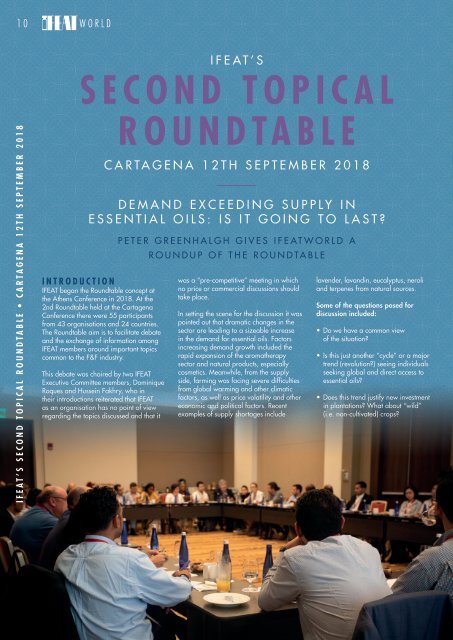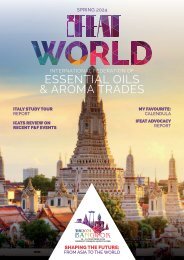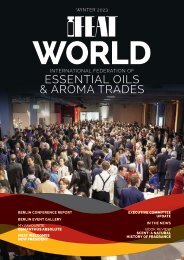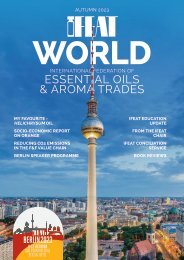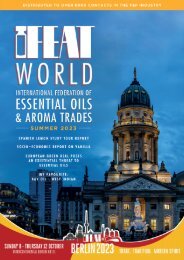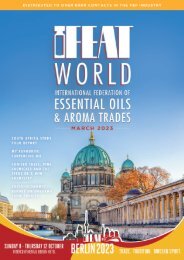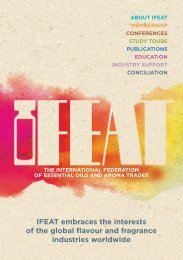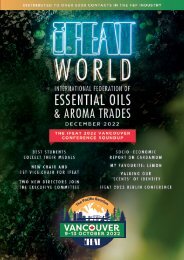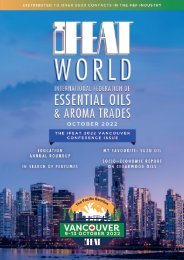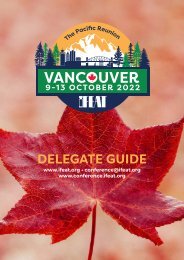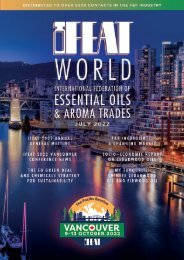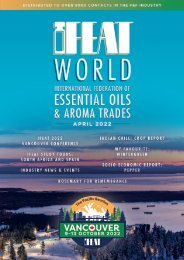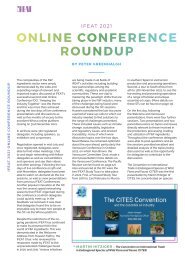Create successful ePaper yourself
Turn your PDF publications into a flip-book with our unique Google optimized e-Paper software.
10<br />
WORLD<br />
WORLD 11<br />
IFEAT’S SECOND TOPICAL ROUNDTABLE • CARTAGENA 12TH SEPTEMBER 2018<br />
IFEAT’S<br />
SECOND TOPICAL<br />
ROUNDTABLE<br />
INTRODUCTION<br />
IFEAT began the Roundtable concept at<br />
the Athens Conference in 2018. At the<br />
2nd Roundtable held at the Cartagena<br />
Conference there were 55 participants<br />
from 43 organisations and 24 countries.<br />
The Roundtable aim is to facilitate debate<br />
and the exchange of information among<br />
IFEAT members around important topics<br />
common to the F&F industry.<br />
This debate was chaired by two IFEAT<br />
Executive Committee members, Dominique<br />
Roques and Hussein Fakhry, who in<br />
their introductions reiterated that IFEAT<br />
as an organisation has no point of view<br />
regarding the topics discussed and that it<br />
CARTAGENA 12TH SEPTEMBER 2018<br />
DEMAND EXCEEDING SUPPLY IN<br />
ESSENTIAL OILS: IS IT GOING TO LAST?<br />
PETER GREENHALGH GIVES <strong>IFEATWORLD</strong> A<br />
ROUNDUP OF THE ROUNDTABLE<br />
was a “pre-competitive” meeting in which<br />
no price or commercial discussions should<br />
take place.<br />
In setting the scene for the discussion it was<br />
pointed out that dramatic changes in the<br />
sector are leading to a sizeable increase<br />
in the demand for essential oils. Factors<br />
increasing demand growth included the<br />
rapid expansion of the aromatherapy<br />
sector and natural products, especially<br />
cosmetics. Meanwhile, from the supply<br />
side, farming was facing severe difficulties<br />
from global warming and other climatic<br />
factors, as well as price volatility and other<br />
economic and political factors. Recent<br />
examples of supply shortages include<br />
lavender, lavandin, eucalyptus, neroli<br />
and terpenes from natural sources.<br />
Some of the questions posed for<br />
discussion included:<br />
• Do we have a common view<br />
of the situation?<br />
• Is this just another “cycle” or a major<br />
trend (revolution?) seeing individuals<br />
seeking global and direct access to<br />
essential oils?<br />
• Does this trend justify new investment<br />
in plantations? What about “wild”<br />
(i.e. non-cultivated) crops?<br />
• Are companies in need of extra<br />
resources to invest directly at source?<br />
• General view: are essential oil<br />
producers or traders facing a threat or<br />
a great opportunity? Are we witnessing<br />
a major change in our industry or a<br />
passing craze?<br />
DEMAND AND SUPPLY<br />
OF ESSENTIAL OILS<br />
The discussion lasted just under two<br />
hours and covered a diverse range of<br />
topics and issues. There was a general<br />
recognition that both the demand and<br />
supply of essential oils was complex.<br />
From the demand side, essential oil<br />
ingredients are used in a very wide<br />
range of flavouring, fragrance and<br />
aromatherapy products. There are<br />
competing uses for many essential oils<br />
and the degree of substitutability varies<br />
from oil to oil and from use to use. From<br />
the supply side there are a large number<br />
of essential oils that are derived from a<br />
wide range of sources – roots, leaves,<br />
annual plants, trees, barks, fruit and<br />
seeds. Supply elasticities vary greatly -<br />
some are by-products (e.g. citrus oils);<br />
some can be harvested for several months<br />
each year; some are tree crops requiring<br />
long gestation periods before yielding<br />
oils. Consumers, including many of the<br />
large retail operations, are becoming<br />
increasingly knowledgeable and<br />
demanding quality products.<br />
The structure of production affects the<br />
supply of essential oils. Smallholders,<br />
often in developing countries, produce<br />
the majority of oils, often alongside<br />
other competing crops. In addition, there<br />
are more organised plantation scale<br />
production operations for some products.<br />
A key factor affecting supply is climate<br />
change, leading to greater volatility in<br />
weather patterns, e.g. droughts, floods,<br />
heat waves, frosts, unseasonal rains, all<br />
of which can create even greater supply<br />
volatility. Global warming is likely to lead<br />
to further dramatic changes in availability<br />
in the medium and longer term. Some<br />
argued that resource availability,<br />
particularly access to land and water,<br />
was diminishing while others argued<br />
that land and finance are available,<br />
particularly in Africa.<br />
The complexity of both demand and<br />
supply variables makes it difficult to<br />
generalise. Trends vary according to<br />
the product. For some oils there is a<br />
definite shortage – for others less so.<br />
Nevertheless, there was a general<br />
consensus that overall demand for<br />
natural products, including essential<br />
oils, was growing, particularly from the<br />
aromatherapy and cosmetics sectors. This<br />
was creating sizeable supply difficulties<br />
and increased prices and this demand<br />
growth was likely to continue. As one<br />
discussant pointed out, “Perhaps at last<br />
“fair prices” are beginning to be paid to<br />
producers for their products”.<br />
ORGANIC AND<br />
PESTICIDES<br />
Particular supply shortages were<br />
highlighted in the organic oils sector –<br />
although this is only a small share of the<br />
overall essential oils market. This was<br />
partly a result of increased demand and<br />
consumer awareness alongside improved<br />
testing procedures able to identify<br />
adulterants. There was a long discussion<br />
of pesticides issues and whether it was<br />
getting worse. Among the points raised<br />
were:<br />
• Measurement of adulterants is much<br />
improved; 30 or 40 years ago there<br />
were lots of pesticides used but<br />
difficult to measure. Today the quality<br />
of most oil is far better than it ever<br />
was before.<br />
• Are developed countries exporting<br />
the pesticide problem by banning<br />
them in their countries but facilitating<br />
companies exporting them to<br />
developing countries?<br />
• Some companies are working on<br />
technological solutions to avoid the<br />
use of pesticides. It is not easy to find<br />
solutions but there is a willingness to<br />
share the technology if needed.<br />
• There is very little investment in<br />
improving organic yields compared<br />
to the amount of money being used<br />
to market pesticides.<br />
• Knowledge of traditional organic<br />
farming is being lost – perhaps<br />
organisations such as IFEAT can help<br />
to spread this knowledge? Perhaps<br />
organisations such as IFEAT can<br />
look at mechanisms of accountability<br />
affecting the whole community and<br />
the globe rather than just specific<br />
products in the EU or USA.<br />
IFEAT’S SECOND TOPICAL ROUNDTABLE • CARTAGENA 12TH SEPTEMBER 2018


